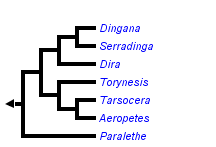Dirini
Niklas Wahlberg and Andrew V. Z. Brower


This tree diagram shows the relationships between several groups of organisms.
The root of the current tree connects the organisms featured in this tree to their containing group and the rest of the Tree of Life. The basal branching point in the tree represents the ancestor of the other groups in the tree. This ancestor diversified over time into several descendent subgroups, which are represented as internal nodes and terminal taxa to the right.

You can click on the root to travel down the Tree of Life all the way to the root of all Life, and you can click on the names of descendent subgroups to travel up the Tree of Life all the way to individual species.
For more information on ToL tree formatting, please see Interpreting the Tree or Classification. To learn more about phylogenetic trees, please visit our Phylogenetic Biology pages.
close boxCharacteristics
The tribe was characterized by Miller (1968) as exhibiting a forewing cell shorter than half the length of the forewing, although his circumscription did not include Aeropetes or Paralethe, both formerly placed in Lethini (Miller, 1968) or Elymniini (Ackery et al. 1995), but now considered to belong to the tribe (Peña et al. 2006; Price et al. 2011). Price et al. indicate that the presence of a scaphium on the male genitalia is the sole known morphological synapomorphy uniting the group (the short forewing cell unites Dira, Dingana Serradinga, Torynesis and Tarsocera.Discussion of Phylogenetic Relationships
Hypothesis of relationships based on the analysis of morphology and molecules by Price et al. (2011).References
Ackery PR, Smith CR, and Vane-Wright RI eds. 1995. Carcasson's African butterflies. Canberra: CSIRO.
Miller, L.D. (1968) The higher classification, phylogeny and zoogeography of the Satyridae (Lepidoptera). Mem. Amer. Entomol. Soc. 24, 1-174.
Peña, C., Wahlberg, N., Weingartner, E., Kodandaramaiah, U., Nylin, S., Freitas, A.V.L. & Brower, A.V.Z. (2006) Higher level phylogeny of Satyrinae butterflies (Lepidoptera: Nymphalidae) based on DNA sequence data. Mol. Phylogenet. Evol. 40, 29-49.
Price, B.W., Villet, M.H., Walton, S.M. & Barker, N.P. (2011) Using molecules and morphology to infer the phylogenetic relationships and evolutionary history of the Dirini (Nymphalidae: Satyrinae), a tribe of butterflies endemic to southern Africa. Systematic Entomology 36, 300-316.
Title Illustrations

| Scientific Name | Dira clytus |
|---|---|
| Location | Cape Town, South Africa |
| Source | Dira clytus |
| Source Collection | Flickr |
| Image Use |
 This media file is licensed under the Creative Commons Attribution-NoDerivs License - Version 2.0. This media file is licensed under the Creative Commons Attribution-NoDerivs License - Version 2.0.
|
| Copyright | © 2006 Nathan Meyers |
About This Page
Niklas Wahlberg

University of Turku, Finland
Andrew V. Z. Brower

Middle Tennessee State University, Murfreesboro, Tennessee, USA
Correspondence regarding this page should be directed to Niklas Wahlberg at
niklas.wahlberg@utu.fi
and Andrew V. Z. Brower at
abrower@mtsu.edu
Page copyright © 2011 Niklas Wahlberg and Andrew V. Z. Brower
 Page: Tree of Life
Dirini .
Authored by
Niklas Wahlberg and Andrew V. Z. Brower.
The TEXT of this page is licensed under the
Creative Commons Attribution License - Version 3.0. Note that images and other media
featured on this page are each governed by their own license, and they may or may not be available
for reuse. Click on an image or a media link to access the media data window, which provides the
relevant licensing information. For the general terms and conditions of ToL material reuse and
redistribution, please see the Tree of Life Copyright
Policies.
Page: Tree of Life
Dirini .
Authored by
Niklas Wahlberg and Andrew V. Z. Brower.
The TEXT of this page is licensed under the
Creative Commons Attribution License - Version 3.0. Note that images and other media
featured on this page are each governed by their own license, and they may or may not be available
for reuse. Click on an image or a media link to access the media data window, which provides the
relevant licensing information. For the general terms and conditions of ToL material reuse and
redistribution, please see the Tree of Life Copyright
Policies.
- First online 25 September 2006
- Content changed 09 December 2011
Citing this page:
Wahlberg, Niklas and Andrew V. Z. Brower. 2011. Dirini . Version 09 December 2011 (under construction). http://tolweb.org/Dirini/70267/2011.12.09 in The Tree of Life Web Project, http://tolweb.org/







 Go to quick links
Go to quick search
Go to navigation for this section of the ToL site
Go to detailed links for the ToL site
Go to quick links
Go to quick search
Go to navigation for this section of the ToL site
Go to detailed links for the ToL site